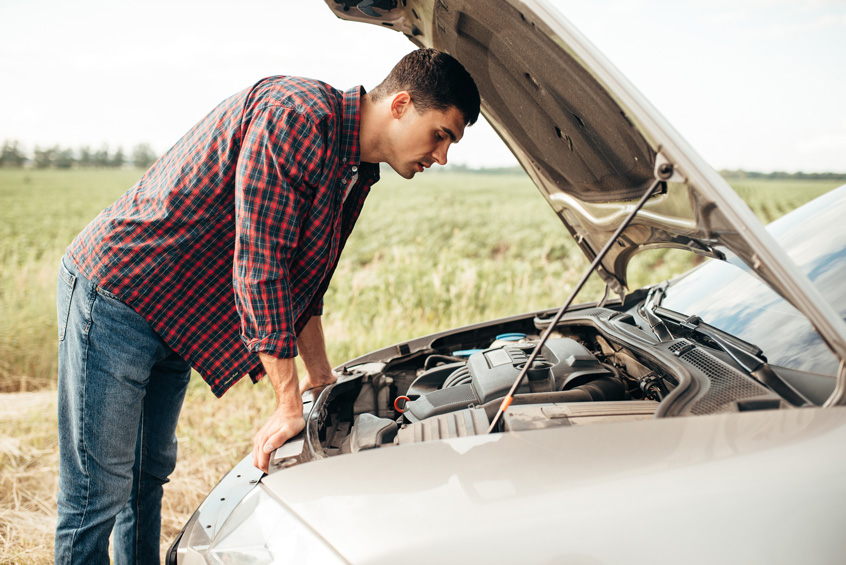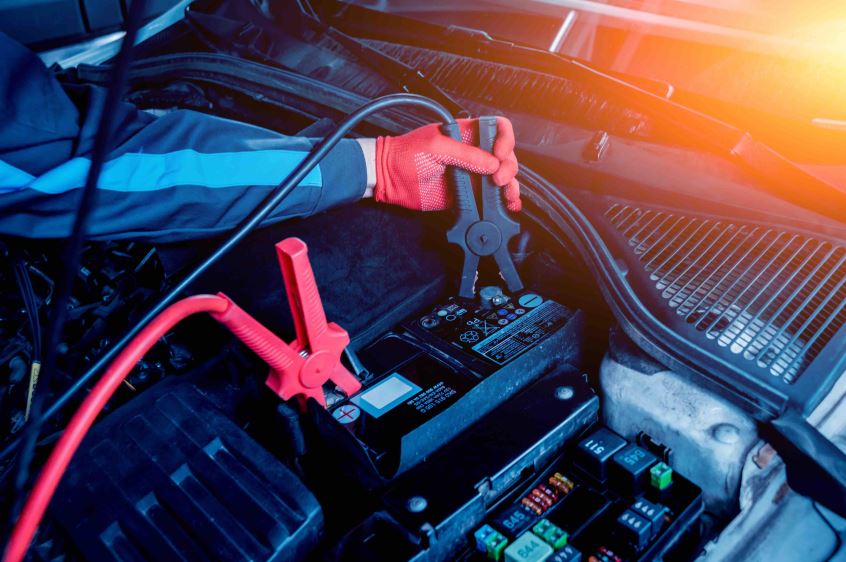
We’ve all experienced that sinking feeling: You’re in a hurry, you’ve got somewhere to be, but when you hop in your car and turn the ignition, nothing happens. Silence, or perhaps a few merciful clicking noises.
Dead car batteries happen to the best of us, but the good news is that there’s an easy (and safe) way to get back on the road, as long as you or one of your parking lot peers has a pair of jumper cables.
Equipment:
- Jumper Cables
- Protective Glasses
- Jumpstarter/Portable Power Unit or A Functioning Vehicle
Step One – Make Sure It’s the Battery
Listen to the sound your car is making when you try to start it.
If you hear absolutely nothing, or a light clicking noise, or even the sound of your engine attempting to turn over, then your battery is probably dead or low and you need to jump-start it.
Step Two – Find a Good Pair of Jumper Cables
If you want to stay out of trouble on the road, make sure you keep a good pair of jumper cables in your trunk.
If you’re purchasing a new pair of jumper cables, keep the length in mind. Jumper cable length usually runs between 10-20 feet. Longer cables can be more convenient depending on the position of the two vehicles. Check the gauge of the cables to determine their power level before you buy. (Lower gauge means higher power; a gauge of six is standard.)
Note: Valvoline recommends using a portable power unit or jumper pack if available. Using jumper cables attached to another vehicle could cause computer issues in modern vehicles. If you own a portable power unit, it will play the role of the second vehicle in the following steps.
Step Three – Take the Necessary Safety Measures

Before jumping off your vehicle, the situation needs to be as safe as possible for all involved.
First, make sure that anybody not actively involved in jumping off your vehicle—especially children—is a safe distance away from the action. Second, if you’ll be attaching the cables yourself, wearing a pair of protective glasses is recommended in case sparks go flying when you attach the cables. Lastly, keep in mind that your jumper cables are transmitting an electric current from one car to another, and they shouldn’t be handled lightly or as a toy.
Also, if you’ve got your owner’s manual handy, check and make sure there aren’t additional precautions needed before jumping off your car.
Step Four – Position Your Vehicles Together
The working vehicle that’ll be jumping yours off needs to be as close as possible, so have the driver park as closely as they can without touching or hindering your mobility—and angle the two cars hood-to-hood if possible.
Make sure both cars are turned off before moving forward as well.
Step Five – Hook the Cables to the Batteries

Make sure the jumper cables are on the ground and the clamps aren’t touching, then open both hoods and locate the batteries.
Now look at both batteries to identify the positive (+) terminal, which should be marked with red. The negative (–) terminal should be marked with black. These will correspond with the colors of the clamps on your jumper cables.
Connect one of the red clamps to the dead battery’s positive (+) post first. Then connect the other red clamp to the good battery’s positive (+) post.
For the black clamps, it’s different: After you attach the corresponding black clamp with the negative (–) post on the good battery, do not attach the remaining black clamp to the dead battery’s negative (–) post! Instead, attach this remaining black clamp to a clean, unpainted metal part of the car under the hood. Attaching the remaining black clamp to the dead battery’s negative (–) post could result in an explosion.
Note: Make sure the positive (+) and negative (–) clamps never touch when the other ends of the cables are attached to a battery. This will generate sparks.
Step Six – Activating the Connection
Once the clamps are all in place, start the working vehicle and let it run for about five minutes. Then start the car with the dead battery. Hopefully this will allow the car to start.
If your vehicle’s engine still won’t turn over, reposition the negative (–) jumper cable to a different clean, unpainted metal surface to see if it strengthens the connection. Or have the driver of the working vehicle step on the gas a bit so that the engine can deliver more amperage.
Once your vehicle has been brought back to life, disconnect the jumper cables in the reverse order as they were connected, then keep the jumped-off car running for at least 30 minutes to give the battery time to recharge.
If jumping off your vehicle doesn’t work after a few attempts, it may be time to replace your battery (most batteries last 4-6 years) and/or call a professional mechanic.
- Prior to using or installing any of these products always consult your vehicle’s owner’s manual for compatibility and warranty information.
- Always take appropriate safety precautions when working on or operating your vehicle. Take the necessary steps to help prevent injuries; always use protective gear like helmets, safety goggles, and gloves.


Don't miss out on new content
Thanks for signing up. Set your password and start earning reward points for everything you do on the site.
You already have a Team Valvoline account. Sign in here.
Did you forget your password?